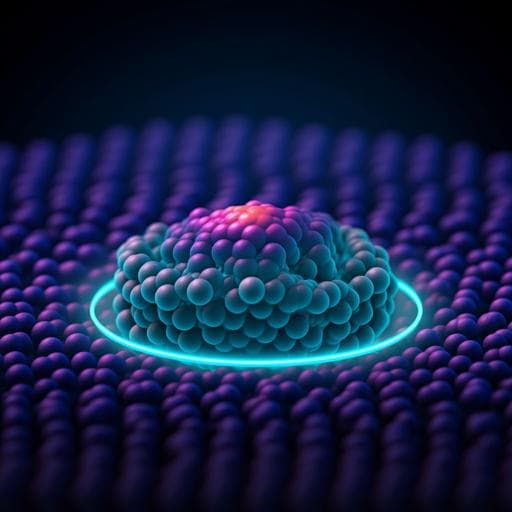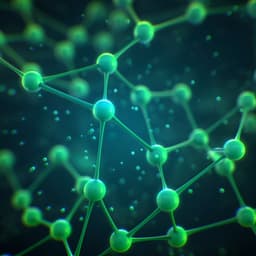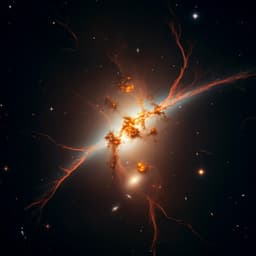
Physics
Understanding the impact of heavy ions and tailoring the optical properties of large-area monolayer WS<sub>2</sub> using focused ion beam
F. Sarcan, N. J. Fairbairn, et al.
This groundbreaking research investigates the lateral damage in large-area monolayer WS2 caused by gallium focused ion beam milling. Conducted by an expert team of authors, the study uncovers an unexpected bright ring-shaped emission around the milled area and reveals strategies to minimize distant damage, paving the way for enhanced optical properties through charge and defect engineering.
~3 min • Beginner • English
Introduction
The study addresses how focused gallium ion beam (FIB) milling affects the optical properties of large-area monolayer WS2 beyond the immediate milling site. While FIB offers nanoscale, all-dry lithography ideal for delicate 2D materials, its lateral damage on atomically thin TMDCs remains poorly understood. The purpose is to characterise and quantify the spatial extent and mechanisms of lateral damage and correlate them with changes in photoluminescence (PL) and Raman signatures. This understanding is important for designing high-performance TMDC-based optoelectronic devices and safely using FIB for defect engineering and nanostructuring without compromising device-scale regions.
Literature Review
Prior work shows ion irradiation can tune TMDC properties by creating chalcogen or metal vacancies, modifying stoichiometry and optical absorption (e.g., Ar ion irradiation in WS2 enhancing near-IR saturable absorption). Ion-dose-controlled defect creation can tune transport in WSe2, and focused He ion beams can generate deterministic defects and percolating defect networks forming edge states in various TMDCs. However, quantitative studies of lateral FIB-induced damage have largely focused on CVD graphene, where lateral impact up to ~30 µm was reported, attributed either to unfocused beam tails or sputtered Ga ions in residual gas. Raman D/G ratios in graphene decrease with distance and reach minima at 15–30 µm from the milled region. For TMDCs, although local defect effects have been investigated, the extended lateral impacts—particularly on light emission—were not previously characterised, motivating this work.
Methodology
- Material growth and transfer: Monolayer WS2 was grown on 2-inch sapphire via Close Coupled Showerhead MOCVD (AIXTRON Ltd.). Large-area monolayers were wet-transferred using PMMA onto pre-patterned SiO2/Si or SiO2 substrates with alignment markers defined by electron-beam lithography and reactive ion etching. PMMA was removed in warm acetone.
- Focused ion beam milling: A dual-beam FIB-SEM (FEI Versa3D) with Ga+ at 30 kV was used. Beam currents from 10 to 3000 pA were tested. A circular area 2 µm in diameter and 50 nm deep was milled with a constant dose of 333.4 pC/µm² (volume-per-dose 240 nm³/nC).
- Steady-state photoluminescence (PL): Micro-PL with 532 nm CW excitation (Novanta gem532), 50× NA 0.55 objective; spot ~1.5 µm; spectra collected with Acton Spectrapro 2750 and cooled CCD (Andor IDUS 420A-BV). PL mapping used a separate setup (532 nm CW Cobolt, 100× NA 0.8 objective, Princeton SP2750, LN2-cooled CCD Princeton PyLoN) scanning at 2.5 µm steps, integrating 590–700 nm.
- Raman spectroscopy: Free-space ultra-low-frequency Raman with 532 nm excitation (Cobolt 04-01), 50× NA 0.55 objective (~1 µm resolution), ~1 mW at sample. Laser line suppression with Bragg notch filters; spectra acquired with Princeton SP2750 and LN2-cooled CCD; 1800 g/mm grating, ~0.4 cm⁻¹ spectral resolution. Automated mapping via motorized xyz stage.
- Time-resolved PL (TRPL): Confocal TCSPC (HydraHarp 400) with two SPAD detectors on a Nikon Ti2-U microscope using a 100× oil-immersion NA 1.45 objective. Excitation: 405 nm pulsed diode (LDH-D-C-405S) at 40 MHz, ~70 ps FWHM pulses. The PL was split by a 638 nm dichroic into <638 nm and >638 nm channels to separate higher-energy excitonic (neutral/trion) from lower-energy defect-bound emission; sample scanned with 2D piezo for PL maps and decays.
- Energy-dispersive X-ray spectroscopy (EDX): Performed in-situ on the FIB-SEM with a Silicon Drift Detector (EDAX Octane Super) at 10 kV electron beam; line scans (100 nm step) and 1024×800 mapping to quantify Ga distributions as a function of beam current.
Key Findings
- Spatially distinct damage zones: Three lateral zones were identified around the milled 2 µm hole: near zone (0–5 µm), dark zone (5–30 µm), and far-out zone (>30 µm). Despite the small milled area, lateral effects extend to at least 30 µm.
- Steady-state PL spectral changes: Pristine ML WS2 shows a neutral exciton (A0) peak at ~2.03 eV, with trion and defect-bound exciton shoulders at ~1.98 eV and ~1.84 eV. The A0–A− energy separation is ~34 meV. Moving from near to far-out zones, the total PL and neutral exciton intensity increase (A0 increases by ~10×; total PL by ~3×). In the near zone, defect-bound emission (D) dominates and the D/A0 intensity ratio increases by a factor of ~4.6 relative to the far-out zone. Trion emission disappears in the near zone, indicating p-type doping from Ga deposition and defect-induced effects.
- Raman defect signatures: The 2LA(M) second-order longitudinal acoustic mode blue-shifts by just over 2 cm⁻¹, from ~350 cm⁻¹ (far-out) to ~352 cm⁻¹ (near), with suppressed intensity near the milled area. The LA(M) mode blue-shifts by ~1 cm⁻¹ and its relative intensity increases with proximity to the milling site. The LA(M):A1g−1–LA(M) intensity ratio increases from ~1:1.1 (pristine) to ~1:1.26 (far-out) and ~1:2.28 (near), consistent with increased vacancy-related defect density and vacancy–phonon scattering within ~30 µm of the epicentre.
- Bright PL ring and excited-state dynamics: TRPL mapping reveals a bright ring encircling the milled hole in the near zone. Spectral channeling with a 638 nm dichroic shows the ring is dominated by shorter-wavelength emission (<638 nm). Lifetime analysis indicates the ring is primarily trion emission with significantly longer decay components than far-out regions. Representative bi-exponential lifetimes (τ, amplitude) are: ring λ>638 nm: 552 ps (0.61) and 2600 ps (0.39); ring λ<638 nm: 586 ps (0.72) and 3200 ps (0.28). Far-out zone: λ>638 nm: 187 ps (0.79), 905 ps (0.21); λ<638 nm: 140 ps (0.77), 429 ps (0.23). Dark zone displays reduced intensity and shorter lifetimes (e.g., λ>638 nm: 149 ps, 539 ps; λ<638 nm: 120 ps, 392 ps).
- Beam current dependence and Ga redeposition: For beam currents 10–100 pA, the dark-zone spatial extent remains similar, with PL recovering linearly with distance and saturating in the far-out zone. However, higher currents reduce far-out zone PL intensity and broaden the PL FWHM, indicating more defect-bound emission. EDX reveals current-dependent Ga+ distributions: low-current (e.g., 30 pA) shows a sharp Ga peak localized at the milling site, whereas high-current (e.g., 3 nA) exhibits a wide-spread Ga distribution leading to long-range lateral damage.
- Damage mechanisms: Short-range damage (≤30 µm) arises from primary ion sputtering and local contamination, creating W and S vacancies and surface charging/doping. Long-range damage (>30 µm) is attributed to redeposition of sputtered Ga+ and milled atoms from residual gas and instrument surfaces. Overall, short-range PL can be reduced to ~10% of pristine levels, while the ring retains about half of the original emission intensity at the edge of the milled area.
Discussion
The results directly address the lateral impact of Ga+ FIB milling on ML WS2 by correlating spatially resolved PL and Raman signatures with ion-beam conditions. Identifying three distinct zones with characteristic spectra and lifetimes clarifies how defects, doping, and charge redistribution evolve away from the milling epicentre. Raman shifts and intensity ratios confirm vacancy formation and enhanced vacancy–phonon scattering within ~30 µm, explaining PL quenching and trion suppression near the epicentre. The discovery of a bright trion-dominated ring highlights localized charge accumulation and/or edge-state formation that enhances trion emission, offering a route to spatially tailor emission channels. The current-dependent far-out damage and EDX-evidenced Ga redeposition substantiate that secondary sputtered ions dominate long-range effects, which can be mitigated by reducing beam current and improving vacuum. These insights guide the design of FIB processes that preserve device-scale regions while enabling controlled, nanoscale defect engineering and optical property tuning in TMDC monolayers.
Conclusion
This work establishes how Ga+ FIB milling induces lateral, distance-dependent modifications in ML WS2, revealing three spatial zones with distinct optical properties and decay dynamics. A trion-dominated bright ring forms near the milled edge, while defect-bound emission and PL quenching prevail closer to the epicentre, and far-out regions recover toward pristine behavior. Raman analyses confirm increased vacancy-related scattering and spectral shifts consistent with defect generation. Long-range damage arises from secondary Ga redeposition and scales with beam current, whereas short-range damage is driven by primary sputtering and local contamination. Reducing ion beam current (and improving vacuum) can suppress weak long-range damage while some local damage remains unavoidable. The demonstrated ability to create spatially and spectrally resolvable emission states with distinct lifetimes suggests FIB as a tool for tailoring TMDC optoelectronic properties and fabricating wafer-scale devices such as single-photon emitters, memory elements, resistors, and atomically thin circuits. Future work could optimize chamber conditions and beam parameters to further minimize long-range redeposition, disentangle charging versus edge-state contributions to ring emission, and extend the approach to other TMDCs and device architectures.
Limitations
- The exact origin of the bright ring emission is not uniquely determined; two mechanisms are proposed (Ga-induced charging versus carrier/edge-state accumulation), requiring further experiments for definitive attribution.
- Long-range damage depends on instrument-specific vacuum conditions and residual gas scattering; generalization to other FIB systems may vary.
- While beam current effects are quantified, short-range damage is reported as unavoidable under the tested conditions; strategies to eliminate it were not demonstrated.
- Quantitative defect densities and comprehensive electrical property correlations were not provided, focusing primarily on optical and Raman signatures.
Related Publications
Explore these studies to deepen your understanding of the subject.







